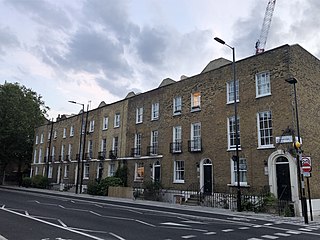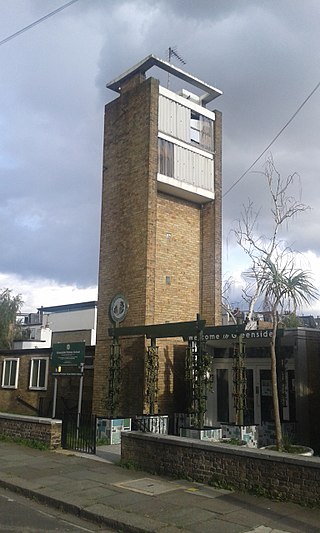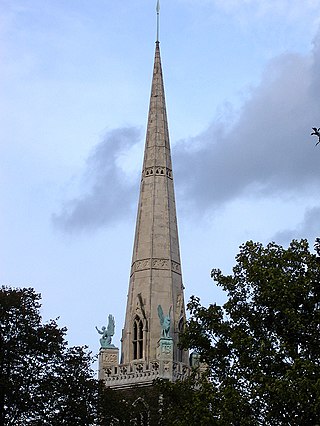
The London Borough of Hackney is a London borough in Inner London, England. The historical and administrative heart of Hackney is Mare Street, which lies 5 miles (8 km) north-east of Charing Cross. The borough is named after Hackney, its principal district. Southern and eastern parts of the borough are popularly regarded as being part of east London that spans some of the traditional East End of London with the northwest belonging to north London. Its population is estimated to be 281,120.

Shoreditch is an area in London, England and is located in the London Borough of Hackney alongside neighbouring parts of Tower Hamlets, which are also perceived as part of the area due to historic ecclesiastical links. Shoreditch lies just north-east of the border with the City of London and is considered to be a part of London's East End.

The Metropolitan Borough of Shoreditch was a metropolitan borough of the County of London between 1899 and 1965, when it was merged with the Metropolitan Borough of Stoke Newington and the Metropolitan Borough of Hackney to form the London Borough of Hackney.

Ernő Goldfinger was a Hungarian-born British architect and designer of furniture. He moved to the United Kingdom in the 1930s, and became a key member of the Modernist architectural movement. He is most prominently remembered for designing residential tower blocks, some of which are now listed buildings.

Metro Central Heights is a group of residential buildings in Walworth in the London Borough of Southwark. It was originally known as Alexander Fleming House, a multi-storey office complex designed by Hungarian-born modernist architect Ernő Goldfinger and constructed in the early 1960s for Arnold Lee of Imry Properties. The design was favoured both by the property developer Imry and by the London County Council as it promised the largest amount of lettable space and therefore the best financial return for the site. Standing at a height of approximately 55 meters at its highest point, the initial plan included three freestanding blocks. Among these, two were seven stories tall, and one was eighteen stories tall, arranged around a central piazza.

Balfron Tower is a 26-storey residential building in Poplar, Tower Hamlets, East London. Built in a Brutalist style, it forms part of the Brownfield Estate, an area of social housing between Chrisp Street Market and the A12 northern approach to the Blackwall Tunnel. It was designed by Ernő Goldfinger in 1963 for the London County Council, built 1965–67 by the GLC, and has been a listed building since 1996. Balfron Tower is stylistically similar to Goldfinger's later Trellick Tower in London.

2 Willow Road is part of a terrace of three houses in Hampstead, London designed by architect Ernő Goldfinger and completed in 1939. It has been managed by the National Trust since 1995 and is open to the public. It was one of the first Modernist buildings acquired by the Trust, giving rise to some controversy. Goldfinger lived there with his wife Ursula and their children until his death in 1987.

De Beauvoir Town is a neighbourhood in the London Borough of Hackney, 2 miles (3.2 km) north of the City of London. The area was a part of Hackney, the Ancient Parish and subsequent Metropolitan Borough that was incorporated into the larger modern borough. It is sometimes described as a part of Dalston, which is in turn also a part of the former parish and borough of Hackney.

Chessington School is a co-educational secondary school with a sports centre, in the Royal Borough of Kingston upon Thames, Greater London. The current building was opened in September 2009.
De Beauvoir is a ward encompassing most of De Beauvoir Town, an area of Dalston in the London Borough of Hackney. The ward forms part of the Hackney South and Shoreditch constituency. The ward has existed since the creation of the borough on 1 April 1965 and was first used in the 1964 elections. The boundaries of the ward were revised in 2014.
Oak Lodge School is a specialist day school with a residential provision for students with hearing, speech, language and communication needs aged 10–19. It is located in the London borough of Wandsworth in England.

Haggerston is an area in London, England and is located in the London Borough of Hackney. It is in East London and part of the East End. There is an electoral ward called Haggerston within the borough.

Haggerston Baths is a former public bath in Haggerston, London. It was opened in 1904 and were built at a cost of £60,000. There was a single pool, 91 slipper baths and a 60 stall wash house.

Henry Thomas Cadbury-Brown RA, also known as H.T. Cadbury-Brown and Jim Cadbury-Brown, was an English architect. He was educated at the Architecture Association where he was influenced by the architecture of Le Corbusier and Walter Gropius. After graduating he worked for architect Ernő Goldfinger and became his lifelong friend. He went on to set up his own successful practice.

The Bridge Academy is a coeducational secondary school and sixth form with academy status, located in the Haggerston area of the London Borough of Hackney in England.

Brandlehow Primary School is in Putney in the London Borough of Wandsworth, the building was designed by Ernő Goldfinger and is Grade II listed.

The Urswick School is a co-educational secondary school and sixth form located in the Hackney Central area of the London Borough of Hackney, London.

Greenside Primary School is a coeducational primary school in Westville Road in Hammersmith, London, England.

Clapton is a district of East London, England, in the London Borough of Hackney.

St Chad's, Haggerston, located on Dunloe Street in Haggerston, is an urban Anglican parish church in the diocese of London, England. Built to designs by architect James Brooks and completed in 1869 as part of the Haggerston Church Scheme, the Grade I Listed church was united with the parish of St Mary, Haggerston in 1953, following the destruction of that church in an air raid in 1941. St Chad's has a historical association with High Church liturgy and Anglo-Catholicism.

















